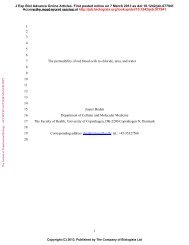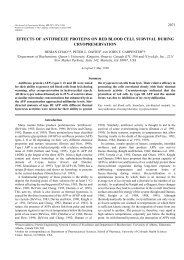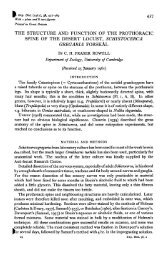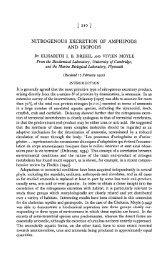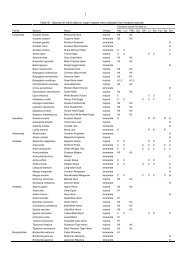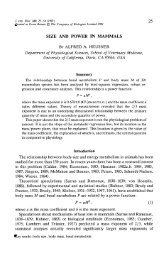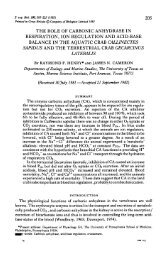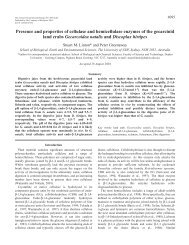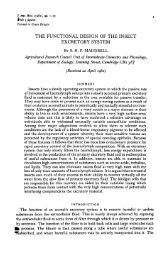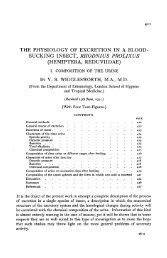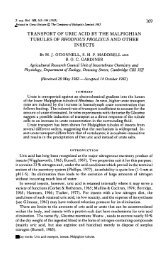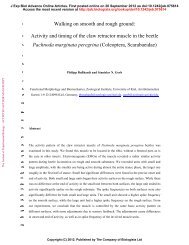the excretory system of the stick insect, dixippus morosus
the excretory system of the stick insect, dixippus morosus
the excretory system of the stick insect, dixippus morosus
You also want an ePaper? Increase the reach of your titles
YUMPU automatically turns print PDFs into web optimized ePapers that Google loves.
THE EXCRETORY SYSTEM OF THE STICK INSECT,<br />
DIXIPPUS MOROSUS (ORTHOPTERA, PHASMIDAE)<br />
BY J. A. RAMSAY<br />
Zoological Laboratory, University <strong>of</strong> Cambridge<br />
{.Received 12 July 1954)<br />
INTRODUCTION<br />
The work which is to be described in this paper is in a sense a by-product <strong>of</strong> an<br />
investigation which is now being made <strong>of</strong> <strong>the</strong> process <strong>of</strong> urine formation in <strong>the</strong><br />
Malpighian tubules <strong>of</strong> <strong>insect</strong>s. The <strong>stick</strong> <strong>insect</strong> has been chosen as a suitable<br />
animal upon which to begin this investigation largely because <strong>of</strong> <strong>the</strong> relative ease<br />
with which its tubules can be studied as isolated preparations. Some <strong>of</strong> this work<br />
has already been published (Ramsay, 1953 b, 1954, 1955). The lack <strong>of</strong> information<br />
upon <strong>the</strong> more general aspects <strong>of</strong> excretion in this <strong>insect</strong> has made itself felt, and<br />
for this reason it was decided that a survey <strong>of</strong> <strong>the</strong> whole <strong>excretory</strong> <strong>system</strong> would<br />
have to be undertaken.<br />
Although <strong>the</strong> Malpighian tubules are commonly regarded as <strong>the</strong> <strong>excretory</strong><br />
organs <strong>of</strong> <strong>insect</strong>s it is becoming increasingly clear that this conception is misleading.<br />
Many <strong>of</strong> <strong>the</strong> substances which are excreted in <strong>the</strong> urine—by which is<br />
meant <strong>the</strong> fluid issuing from <strong>the</strong> tubules—are reabsorbed in o<strong>the</strong>r parts <strong>of</strong> <strong>the</strong> gut,<br />
in particular in <strong>the</strong> rectum. The <strong>excretory</strong> <strong>system</strong> is here understood to be <strong>the</strong><br />
Malpighian tubules, toge<strong>the</strong>r with <strong>the</strong> whole <strong>of</strong> <strong>the</strong> hindgut; but even this wider<br />
definition may not always be adequate since it does not include regions <strong>of</strong> <strong>the</strong> body<br />
in which <strong>excretory</strong> matter may be stored (e.g. uric acid in <strong>the</strong> fat-body <strong>of</strong> <strong>the</strong> cockroach)<br />
and takes no account <strong>of</strong> o<strong>the</strong>r routes (e.g. <strong>the</strong> genital <strong>system</strong>) by which, as so<br />
happens in <strong>the</strong> <strong>stick</strong> <strong>insect</strong>, <strong>the</strong> bulk <strong>of</strong> <strong>the</strong> calcium leaves <strong>the</strong> body.<br />
It is necessary to correct any impression that all possible technical resources,<br />
even <strong>the</strong> limited technical resources available for physiological studies upon small<br />
animals, have been brought to bear upon this problem. Ra<strong>the</strong>r, it must be<br />
emphasized that this work is in <strong>the</strong> nature <strong>of</strong> a preliminary study and aims no<br />
fur<strong>the</strong>r than to establish <strong>the</strong> broad outlines, leaving much detail still to be filled in.<br />
MATERIAL AND METHODS<br />
Except where o<strong>the</strong>rwise stated, <strong>the</strong> results reported in this paper refer to <strong>the</strong> adult<br />
female <strong>stick</strong> <strong>insect</strong>, bred in <strong>the</strong> laboratory on <strong>the</strong> leaves <strong>of</strong> privet.<br />
The methods used for <strong>the</strong> collection <strong>of</strong> fluids from various parts <strong>of</strong> <strong>the</strong> body<br />
cannot conveniently be summarized here, but will be described briefly in <strong>the</strong><br />
appropriate context.<br />
The methods <strong>of</strong> analysis used were as follows. Sodium and potassium; flame<br />
photometry (Ramsay, Brown & Falloon, 1953). Calcium; precipitation (twice) as
184 J. A. RAMSAY<br />
oxalate and titration with eerie sulphate (Kirk, 1950). Magnesium; titan yellow<br />
method (Orange & Rhein, 1951). Chloride; potentiometric titration with silver<br />
nitrate using apparatus devised by Mr P. C. Croghan, whom I wish to thank for<br />
instruction in <strong>the</strong> method. Phosphate; ammonium molybdate method as described<br />
by Delory (1949), adapted for 1 ml. cells. Uric acid; Benedict's arsenophosphotungstic<br />
method as described by Delory, adapted for 1 ml. cells. Osmotic pressure;<br />
cryoscopic method (Ramsay, 1949). pH; micro glass electrode (Hartree, 1952);<br />
I am indebted to Dr E. W. McConnachie for this measurement. Paper chromatography<br />
has been used as a qualitative method.<br />
ANATOMY AND HISTOLOGY<br />
A general account <strong>of</strong> <strong>the</strong> Phasmidae has been given by de Sinety (1901). His<br />
description goes into great detail <strong>of</strong> some regions <strong>of</strong> <strong>the</strong> gut and its appendages<br />
while o<strong>the</strong>rs, e.g. <strong>the</strong> whole <strong>of</strong> <strong>the</strong> hindgut, receive no mention at all.<br />
The general arrangement <strong>of</strong> <strong>the</strong> <strong>excretory</strong> <strong>system</strong> is illustrated diagrammatically<br />
in Fig. 1. As is commonly <strong>the</strong> case in primitive <strong>insect</strong>s <strong>the</strong> Malpighian tubules<br />
arise from an annulus which marks <strong>the</strong> division between midgut and hindgut.<br />
Midgut<br />
Intestine<br />
Inferior tubule<br />
Fig.' 1. (a) To show position <strong>of</strong> region illustrated in (6). (6) Malpighian<br />
tubules and posterior region <strong>of</strong> gut.<br />
There is no sphincter or constriction in this region. The anterior region <strong>of</strong> <strong>the</strong><br />
hindgut, which will be called <strong>the</strong> intestine, is separated from <strong>the</strong> short rectum by<br />
a sphincter which is normally closed. The three types <strong>of</strong> Malpighian tubule<br />
recognized by de Sine"ty are distinguished most readily by <strong>the</strong>ir anatomical relations<br />
with <strong>the</strong> gut and o<strong>the</strong>r structures.<br />
(a) The superior tubules arise from <strong>the</strong> annulus, run forward a short distance<br />
and <strong>the</strong>n turn back following <strong>the</strong> intestine to which each tubule is attached by<br />
several short tracheae. These arise from <strong>the</strong> tracheal supply which invests <strong>the</strong><br />
hindgut and on reaching <strong>the</strong> tubule each trachea divides into ascending and<br />
descending branches which supply a short length <strong>of</strong> tubule. Towards <strong>the</strong> distal
The <strong>excretory</strong> <strong>system</strong> <strong>of</strong> <strong>the</strong> <strong>stick</strong> <strong>insect</strong> 185<br />
(bKnd) end <strong>the</strong> tubule is more contorted and ends at about <strong>the</strong> level <strong>of</strong> <strong>the</strong> rectal<br />
sphincter. The tubules <strong>of</strong> <strong>the</strong> nymph correspond to <strong>the</strong> superior tubules <strong>of</strong> <strong>the</strong><br />
adult.<br />
(b) The inferior tubules arise from <strong>the</strong> annulus in pairs having a very short<br />
common trunk and run at first directly backwards. The distal region <strong>of</strong> <strong>the</strong> inferior<br />
tubule, which may represent one-third or more <strong>of</strong> its total length, is in <strong>the</strong> form<br />
<strong>of</strong> a dilatation containing white granules; it is not closely applied to <strong>the</strong> gut but lies<br />
free in <strong>the</strong> posterior body cavity being attached at its blind end by short tracheal<br />
branches to <strong>the</strong> connective tissue <strong>of</strong> <strong>the</strong> fat-body. The blind end itself is provided<br />
with a cap <strong>of</strong> cells <strong>of</strong> vesicular appearance, <strong>the</strong> cells <strong>of</strong> Sirodot, between which <strong>the</strong><br />
tracheal branches pass to spread out over <strong>the</strong> distal dilatation. The only o<strong>the</strong>r<br />
tracheal supply is a single branch which applies itself to <strong>the</strong> tubule at <strong>the</strong> proximal<br />
end and runs in a loose spiral over <strong>the</strong> proximal and middle regions. There are no<br />
inferior tubules in <strong>the</strong> nymph and <strong>the</strong>y are poorly developed in <strong>the</strong> male (de<br />
Sinety).<br />
(c) The tubules <strong>of</strong> <strong>the</strong> third kind ('appendices <strong>of</strong> <strong>the</strong> midgut') open separately<br />
into small pyriform dilatations <strong>of</strong> <strong>the</strong> midgut wall anterior to <strong>the</strong> annulus. They<br />
are thinner than <strong>the</strong> superior and inferior tubules and more contorted. They run<br />
directly back to end close to <strong>the</strong> intestine about one-third <strong>of</strong> <strong>the</strong> distance from <strong>the</strong><br />
annulus to <strong>the</strong> sphincter.<br />
All three types <strong>of</strong> tubule are provided with muscular elements running in loose<br />
spirals over <strong>the</strong>ir walls and can be seen to undergo gentle writhing movements.<br />
In each <strong>of</strong> two <strong>insect</strong>s an accurate count was made <strong>of</strong> <strong>the</strong> tubules <strong>of</strong> <strong>the</strong> three<br />
types, which were found to be present in <strong>the</strong> following numbers: superior tubules<br />
24, 23; inferior tubules 134, 134; appendices <strong>of</strong> <strong>the</strong> midgut 32, 25.<br />
The appearance <strong>of</strong> <strong>the</strong> epi<strong>the</strong>lium in <strong>the</strong> different regions <strong>of</strong> <strong>the</strong> gut has been<br />
studied in sections fixed in Susa, cut at 10/x and stained in iron haematoxylin. At<br />
<strong>the</strong> region <strong>of</strong> <strong>the</strong> annulus <strong>the</strong> columnar epi<strong>the</strong>lium <strong>of</strong> <strong>the</strong> midgut gives way to <strong>the</strong><br />
cubical epi<strong>the</strong>lium <strong>of</strong> <strong>the</strong> intestine and this in turn to <strong>the</strong> tall columnar epi<strong>the</strong>lium<br />
<strong>of</strong> <strong>the</strong> six rectal glands. These epi<strong>the</strong>lia are illustrated in Fig. 2.<br />
The Malpighian tubules have been examined alive in haemolymph and are<br />
illustrated in Fig. 3.<br />
(a) Superior tubules. When observed under <strong>the</strong> low power <strong>the</strong> cells <strong>of</strong> <strong>the</strong> healthy<br />
tubule appear as a bright transparent colourless wall whose inner margin is made<br />
discernible by <strong>the</strong> presence <strong>of</strong> granules <strong>of</strong> various kinds and in varying amount. In<br />
<strong>the</strong> middle and proximal regions <strong>the</strong> granules have a greenish yellow colour, in <strong>the</strong><br />
distal region <strong>the</strong>y are white and <strong>the</strong> tip is generally devoid <strong>of</strong> granules. When <strong>the</strong><br />
<strong>insect</strong> has been feeding regularly very few granules are present, but when <strong>the</strong><br />
<strong>insect</strong> has fasted for 3 or 4 days <strong>the</strong> tubule appears to be packed with granules<br />
which, however, are not free in <strong>the</strong> lumen but are attached in masses to <strong>the</strong> inner<br />
margin <strong>of</strong> <strong>the</strong> wall. These granules are soluble in dilute alkali but not in dilute acid.<br />
An alkaline extract <strong>of</strong> <strong>the</strong> tubules <strong>of</strong> fasting <strong>insect</strong>s contains more than 20 times as<br />
much uric acid as a similar extract <strong>of</strong> <strong>the</strong> tubules <strong>of</strong> fed <strong>insect</strong>s. This suggests that<br />
<strong>the</strong>se granules contain uric acid; <strong>the</strong>y do not, however, have <strong>the</strong> appearance <strong>of</strong> <strong>the</strong>
186 J. A. RAMSAY<br />
uratic spheres known from <strong>the</strong> urine <strong>of</strong> Rhodmus nor do <strong>the</strong>y appear to be enmeshed<br />
by <strong>the</strong> filaments <strong>of</strong> <strong>the</strong> brush border as in that <strong>insect</strong> (Wigglesworth,<br />
1931a, b).<br />
(C)<br />
100/t<br />
Circular mutcle<br />
Clrculir mutcle<br />
Longitudinal muscle Circular muide<br />
Fig. a. Wall <strong>of</strong> gut in transverse section. From material fixed in Susa and stained<br />
in iron haematoxylin. (a) Midgut. (6) Intestine, (c) Rectum.<br />
Over most <strong>of</strong> <strong>the</strong> length <strong>of</strong> <strong>the</strong> tubule <strong>the</strong> cells (which are bi-nucleate, de Sin6ty)<br />
are provided with a well-developed brush border which has no clearly defined<br />
inner margin and is <strong>the</strong>refore <strong>of</strong> <strong>the</strong> ' biirstensaum' type (Wigglesworth, 1931 b). At<br />
<strong>the</strong> proximal end <strong>the</strong> diameter is greatest, about 120/1, and <strong>the</strong> brush border is
The <strong>excretory</strong> <strong>system</strong> <strong>of</strong> <strong>the</strong> <strong>stick</strong> <strong>insect</strong> 187<br />
deep, but with very fine striations and a very indefinite inner margin. Towards <strong>the</strong><br />
middle region <strong>the</strong> diameter decreases to about ioo/x, <strong>the</strong> brush border becomes<br />
a little less deep and <strong>the</strong> striations (filaments) are clearer and all <strong>of</strong> <strong>the</strong> same length<br />
which defines <strong>the</strong> inner margin, although no surface can be brought to focus<br />
(Fig. 36). The diameter <strong>of</strong> <strong>the</strong> distal region is about 8o/i. Over <strong>the</strong> last 2 or 3 mm.<br />
at <strong>the</strong> tip <strong>the</strong> character <strong>of</strong> <strong>the</strong> border changes. The filaments are shorter and<br />
ga<strong>the</strong>red into clumps, ra<strong>the</strong>r in <strong>the</strong> way that <strong>the</strong> hairs <strong>of</strong> an animal's fur are held<br />
toge<strong>the</strong>r by surface tension when wet, and <strong>the</strong> inner margin can be brought to<br />
focus (Fig. 3 a).<br />
• • • • ' • ' • • - ' • ' • • • • • < $ • ( •<br />
25/i Basement membrane<br />
Fig. 3. Walls <strong>of</strong> Malpighian tubules. From living material, (a) Superior tubule, distal region,<br />
showing change in brush border near <strong>the</strong> tip (left); in serum, (b) Superior tubule, middle<br />
region; in serum, (c) 'Appendix <strong>of</strong> midgut'; in serum. (
188 J. A. RAMSAY<br />
<strong>the</strong>se granules is calcium carbonate. The egg shells <strong>of</strong> phasmids are hardened with<br />
calcium oxalate (Moscona, 1950). Since <strong>the</strong> inferior tubules with <strong>the</strong>ir dilatations<br />
and granules are absent in <strong>the</strong> nymph and poorly developed in <strong>the</strong> male, and since<br />
<strong>the</strong> granules appear to be reduced in quantity during fasting (egg production<br />
continuing), it seems likely that <strong>the</strong>y are a calcium reserve which can be drawn<br />
upon to provide material for <strong>the</strong> egg shells.<br />
(c) Appendices <strong>of</strong> <strong>the</strong> midgut. These tubules are narrower (c. 50/i) than <strong>the</strong> o<strong>the</strong>rs<br />
and are uniform throughout <strong>the</strong>ir length. There is a well-developed brush border<br />
and <strong>the</strong> inner margin can be brought to focus (Fig. 3 c). It is perhaps less sharply<br />
defined than <strong>the</strong> scalloped edge <strong>of</strong> <strong>the</strong> 'wabensaum' in Rhodnius (Wigglesworth,<br />
1931ft), but more definite than <strong>the</strong> edge <strong>of</strong> <strong>the</strong> border as seen at <strong>the</strong> tip <strong>of</strong> <strong>the</strong><br />
superior tubule (Fig. 3 a). No granules have been seen in <strong>the</strong>se tubules.<br />
Wigglesworth has reported that in Rhodnius <strong>the</strong> normal histological appearance<br />
<strong>of</strong> <strong>the</strong> tubules is not preserved in artificial media. The same is true <strong>of</strong> <strong>the</strong> tubules<br />
<strong>of</strong> <strong>the</strong> <strong>stick</strong> <strong>insect</strong> in all artificial media as yet tested. A Ringer solution approximating<br />
to haemolymph in composition has been prepared (Ramsay, 1955). Within<br />
an hour or two after being placed in Ringer <strong>the</strong> walls <strong>of</strong> <strong>the</strong> tubules begin to lose<br />
<strong>the</strong>ir characteristic bright appearance. The striations <strong>of</strong> <strong>the</strong> brush border become<br />
fainter and <strong>the</strong> border eventually disintegrates. The appearance <strong>of</strong> <strong>the</strong> nuclei<br />
changes with what appears to be <strong>the</strong> separation <strong>of</strong> a coagulum from a clear fluid<br />
within <strong>the</strong> nuclear membrane (Fig. 3d). A space appears between <strong>the</strong> cells and <strong>the</strong><br />
basement membrane which is clearly visible only under <strong>the</strong>se conditions, and after<br />
5 or 6 hr. a disintegrating mass <strong>of</strong> cells fills <strong>the</strong> lumen. The contraction <strong>of</strong> <strong>the</strong><br />
muscular elements in <strong>the</strong> walls continues for some time longer.<br />
Table 1. Relative quantities <strong>of</strong> mineral bases as percentage<br />
<strong>of</strong> toted mineral base expressed in equivalents<br />
Na<br />
K<br />
Ca<br />
Mg<br />
Privet<br />
leaves<br />
(1)<br />
13<br />
35<br />
46<br />
6<br />
100<br />
Nymph<br />
faeces<br />
(2)<br />
9<br />
33<br />
Si<br />
7<br />
100<br />
Adult<br />
faeces<br />
(3)<br />
EXCHANGE OF MINERAL BASES<br />
The <strong>insect</strong> takes in sodium, potassium, calcium and magnesium in <strong>the</strong> proportions<br />
in which <strong>the</strong>y are present in privet leaves (Table 1, col. 1), and should presumably<br />
eliminate <strong>the</strong>m in <strong>the</strong> same proportions. In <strong>the</strong> case <strong>of</strong> <strong>the</strong> nymph elimination is<br />
entirely by way <strong>of</strong> <strong>the</strong> faeces, and it is found that in <strong>the</strong> faeces <strong>of</strong> <strong>the</strong> nymph <strong>the</strong><br />
four bases are present in much <strong>the</strong> same proportions as in <strong>the</strong> leaves (Table 1,<br />
col. 2). In <strong>the</strong> case <strong>of</strong> <strong>the</strong> adult female <strong>the</strong> eggs constitute a second channel <strong>of</strong><br />
elimination. The rate <strong>of</strong> egg production is considerable and in terms <strong>of</strong> ash a somewhat<br />
greater weight is eliminated as eggs than as faeces. It is difficult, however, to<br />
11<br />
66 8<br />
15<br />
100<br />
Eggs<br />
(4)<br />
10<br />
5<br />
83 2<br />
100
The <strong>excretory</strong> <strong>system</strong> <strong>of</strong> <strong>the</strong> <strong>stick</strong> <strong>insect</strong> 189<br />
make out a balance sheet since <strong>the</strong>re is at any time a large number <strong>of</strong> eggs in <strong>the</strong><br />
body at various stages <strong>of</strong> development, and a large and variable store <strong>of</strong> calcium<br />
in <strong>the</strong> inferior tubules. Cols. 3 and 4, Table i,.show that most <strong>of</strong> <strong>the</strong> potassium<br />
and magnesium is eliminated in <strong>the</strong> faeces while most <strong>of</strong> <strong>the</strong> calcium is eliminated<br />
in <strong>the</strong> eggs.<br />
THE HAEMOLYMPH<br />
No extensive analysis <strong>of</strong> <strong>stick</strong>-<strong>insect</strong> haemolymph, comparable with Levenbook's<br />
(1950) analysis for Gastrophilus, has yet been made, but a certain amount <strong>of</strong> information<br />
from various sources is assembled in Table 2, col. 1. The <strong>stick</strong> <strong>insect</strong><br />
conforms to <strong>the</strong> usual pattern <strong>of</strong> <strong>the</strong> herbivorous <strong>insect</strong> in that its haemolymph<br />
contains more potassium than sodium and more magnesium than calcium. It also<br />
contains a great deal <strong>of</strong> phosphate and appears to be supersaturated with respect<br />
to magnesium phosphate.<br />
Table 2<br />
PH<br />
A<br />
Na<br />
K<br />
Ca<br />
Mg<br />
Cl<br />
POJ-<br />
Uric acid<br />
Haemolymph<br />
(1)<br />
160 mM./l. NaCl*<br />
8'7 m.equiv./l.f<br />
27-5 m.equiv./l.f<br />
i6-2 m.equiv./1-t<br />
145 m.equiv./l.f<br />
93 m.equiv./l.j<br />
120 m.equiv./l.<br />
IO'4 mg./ioo ml.§<br />
Serum<br />
(2)<br />
6-6<br />
171 mM./l. NaCl<br />
11 m.equiv./l.<br />
18 m.equiv./l.<br />
7 m.equiv./l.<br />
108 m.equiv./l.<br />
87 m.equiv./l.<br />
39 m.equiv./l.<br />
4-5 mg./ioo ml.<br />
Urine<br />
(3)<br />
6-8-7-5<br />
171 mM./l. NaCl<br />
5 m.equiv./l.<br />
145 m.equiv./l.<br />
2 m.equiv./l.<br />
18 m.equiv./l.<br />
65 m.equiv./l.<br />
51 m.equiv./l.<br />
43 mg./ioo ml.<br />
• Rouschal (1940). t Duchateau et al. (1953). % May (1935). § Florkin (1936).<br />
The fresh haemolymph <strong>of</strong> <strong>the</strong> <strong>stick</strong> <strong>insect</strong> is not a very convenient medium for<br />
physiological work since it almost invariably coagulates during <strong>the</strong> course <strong>of</strong> an<br />
experiment. It has been found that if <strong>the</strong> fresh haemolymph is heated to 100° C.<br />
for about 5 min. and <strong>the</strong>n centrifuged, a fluid, which will here be called serum, is<br />
separated from a compacted clot. This fluid still preserves <strong>the</strong> characteristic bluegreen<br />
colour <strong>of</strong> fresh haemolymph which, according to Abeloos & Touman<strong>of</strong>f<br />
(1926) is due to 'carotinalbumines'. As a physiological medium for Malpighian<br />
tubules it does not appear to be in any way inferior to fresh haemolymph, and has<br />
been extensively used in an investigation which is reported elsewhere (Ramsay,<br />
1955). An analysis <strong>of</strong> serum is given in Table 2, col. 2. The concentrations <strong>of</strong><br />
calcium, magnesium and phosphate are reduced as compared with haemolymph,<br />
and it is probable that earthy phosphates have been precipitated and removed with<br />
<strong>the</strong> clot. Even if all <strong>the</strong> phosphate is present as POJ~, which is unlikely, <strong>the</strong>re is an<br />
anion deficit <strong>of</strong> about 20 m.equiv./l. in serum.<br />
A word <strong>of</strong> comment is needed on <strong>the</strong> subject <strong>of</strong> sodium and potassium concentrations.<br />
The figures given by Duchateau, Florkin & Leclercq (1953) show<br />
a lower concentration <strong>of</strong> sodium and a higher concentration <strong>of</strong> potassium than do<br />
<strong>the</strong> figures for serum (Table 2, cf. cols. 1 and 2). This difference is not due to <strong>the</strong><br />
heat-treatment <strong>of</strong> serum since <strong>the</strong> same concentrations are found in <strong>the</strong> haemolymph
190 J. A. RAMSAY<br />
from which serum is prepared. Later in this paper (Table 5) fur<strong>the</strong>r figures are<br />
given for haemolymph, showing higher sodium and lower potassium than in<br />
serum. When this inconsistency was discovered investigation was made into its<br />
cause. The collections <strong>of</strong> haemolymph from which serum was prepared were made<br />
by cutting <strong>of</strong>f a leg and drawing up <strong>the</strong> haemolymph into a tube, <strong>the</strong> exudation <strong>of</strong><br />
haemolymph being assisted by light pressure applied to <strong>the</strong> <strong>insect</strong>'s body with <strong>the</strong><br />
fingers. A number <strong>of</strong> <strong>insect</strong>s were subjected to this treatment and <strong>the</strong>n dissected,<br />
and in some <strong>of</strong> <strong>the</strong>m it was found that <strong>the</strong> midgut was perforated near <strong>the</strong> annulus.<br />
The effect <strong>of</strong> this would be to contaminate <strong>the</strong> haemolymph with urine having a<br />
low sodium and high potassium concentration. It is possible that similar contamination<br />
affected <strong>the</strong> collections made by Duchateau et al. (1953) in greater degree.<br />
Duchlteau, Sarlet & Florkin (1952), using methods <strong>of</strong> biological assay, have<br />
given an extensive list <strong>of</strong> amino-acids, free or combined in a non-protein form,<br />
found in <strong>stick</strong>-<strong>insect</strong> haemolymph. In <strong>the</strong> present work a brief investigation using<br />
paper chromatography was made <strong>of</strong> haemolymph de-proteinized with trichloracetic<br />
acid. Only two ninhydrin-positive compounds which withstood hydrolysis with<br />
concentrated hydrochloric acid were found in substantial concentration; one <strong>of</strong><br />
<strong>the</strong>se was glycine, <strong>the</strong> o<strong>the</strong>r could not be identified by Rp values. An imposing<br />
array <strong>of</strong> spots appeared after hydrolysis, but <strong>the</strong>se were not fur<strong>the</strong>r studied.<br />
It is concluded that most <strong>of</strong> <strong>the</strong> amino-acids recoverable from de-proteinized<br />
haemolymph are present as peptides.<br />
The total volume <strong>of</strong> <strong>the</strong> haemolymph in a <strong>stick</strong> <strong>insect</strong> can be found approximately<br />
in <strong>the</strong> following way. A leg is cut <strong>of</strong>f, as much haemolymph as possible is<br />
collected and its volume measured in a capillary pipette. An equal volume <strong>of</strong><br />
Ringer solution is <strong>the</strong>n injected, and after about half an hour has been allowed for<br />
it to become uniformly distributed a second sample <strong>of</strong> haemolymph is taken. Both<br />
first and second samples are <strong>the</strong>n heat-coagulated and centrifuged. The dilution<br />
<strong>of</strong> <strong>the</strong> second sample is found by adding Ringer to <strong>the</strong> first sample until <strong>the</strong> same<br />
depth <strong>of</strong> blue-green colour is obtained. A simple calculation <strong>the</strong>n gives <strong>the</strong> total<br />
volume <strong>of</strong> haemolymph in <strong>the</strong> <strong>insect</strong>. Figures thus obtained ranged from 76 to<br />
186 mm. 3 with an average value <strong>of</strong> 132 mm. 3 for six <strong>insect</strong>s. The average weight <strong>of</strong><br />
an adult female <strong>stick</strong> <strong>insect</strong> is 0*8 g., so that <strong>the</strong> haemolymph represents about<br />
15 % <strong>of</strong> <strong>the</strong> <strong>insect</strong>'s weight.<br />
THE URINE<br />
Sufficient urine to make possible <strong>the</strong> analyses in Table 2, col. 3, was collected in <strong>the</strong><br />
following way. The <strong>insect</strong> was fastened down on its back with plasticine, and <strong>the</strong><br />
abdomen was opened along <strong>the</strong> mid-ventral line. A cotton-thread ligature was tied<br />
around <strong>the</strong> intestine just posterior to <strong>the</strong> annulus, passing between <strong>the</strong> intestine<br />
and <strong>the</strong> Malpighian tubules so as to leave <strong>the</strong> latter free. A slit was <strong>the</strong>n made into<br />
<strong>the</strong> midgut wall about 2 mm. anterior to <strong>the</strong> annulus, <strong>the</strong> gut contents were removed<br />
and a cannula was tied into place, <strong>the</strong> ligature passing just anterior to <strong>the</strong> annulus.<br />
In this way it was possible to collect <strong>the</strong> fluid, presumably urine, accumulating in<br />
<strong>the</strong> short stretch <strong>of</strong> gut between <strong>the</strong> ligatures. Urine was produced at rates <strong>of</strong>
The <strong>excretory</strong> <strong>system</strong> <strong>of</strong> <strong>the</strong> <strong>stick</strong> <strong>insect</strong> 191<br />
40-6-5 mm. 3 /hr. The urine rose in <strong>the</strong> cannula as a pale yellow fluid soon becoming<br />
dark brown on exposure to air.<br />
As was already known, <strong>the</strong> potassium concentration is higher and <strong>the</strong> sodium<br />
concentration is lower in <strong>the</strong> urine than in <strong>the</strong> haemolymph. Calcium, magnesium<br />
and chloride are lower in <strong>the</strong> urine, but phosphate is higher. There is an apparent<br />
anion deficit <strong>of</strong> some 50 m.equiv./l. Uric acid is in higher concentration in <strong>the</strong><br />
urine as might be expected.<br />
CHANGES IN THE URINE DURING ITS PASSAGE<br />
THROUGH INTESTINE AND RECTUM<br />
In this and in <strong>the</strong> next section consideration is restricted to water, sodium and<br />
potassium. Methods <strong>of</strong> analysis suitable for <strong>the</strong> small volumes available have not<br />
yet been developed for o<strong>the</strong>r constituents <strong>of</strong> <strong>the</strong> urine.<br />
It is immediately obvious that with urine being produced at a rate <strong>of</strong> about<br />
6 mm. 3 /hr. all <strong>the</strong> water would be removed from <strong>the</strong> haemolymph in less than<br />
24 hr. if it were not reabsorbed in <strong>the</strong> hindgut. It is also obvious that all <strong>the</strong><br />
potassium in <strong>the</strong> haemolymph would be removed in less than 3 hr. and <strong>the</strong>refore<br />
potassium, like water, must presumably be reabsorbed. To demonstrate such<br />
reabsorption is not altoge<strong>the</strong>r a straightforward problem since besides <strong>the</strong> urine<br />
semi-digested food containing potassium is being passed into <strong>the</strong> hindgut at an<br />
unknown rate. This complication can be avoided by using fasting <strong>insect</strong>s.<br />
For <strong>the</strong>se experiments <strong>the</strong> <strong>insect</strong>s were kept without food in glass jars lined with<br />
moist filter-paper, in which <strong>the</strong>y could survive for more than 10 days. The production<br />
<strong>of</strong> faeces fell <strong>of</strong>f rapidly from about 20 mg. to about 2 mg. dry weight per<br />
<strong>insect</strong> per day. 20 mg. <strong>of</strong> 'fasting' faeces were ashed and found to contain 0-3 ^equiv.<br />
<strong>of</strong> sodium and i8^equiv. <strong>of</strong> potassium; this indicates a loss <strong>of</strong> c-03/xequiv. <strong>of</strong><br />
sodium and i-8/xequiv. <strong>of</strong> potassium per <strong>insect</strong> per day. From figures already<br />
quoted it can be calculated that <strong>the</strong> Malpighian tubules will excrete c-7/xequiv. <strong>of</strong><br />
sodium and 2i^equiv. <strong>of</strong> potassium in one day, so that considerable reabsorption<br />
must take place.<br />
This <strong>of</strong> course presupposes that <strong>the</strong> rate <strong>of</strong> flow and composition <strong>of</strong> <strong>the</strong> urine<br />
are maintained at <strong>the</strong> same levels in <strong>the</strong> fasting <strong>insect</strong>. The conspicuous accumulation<br />
<strong>of</strong> granules in <strong>the</strong> Malpighian tubules <strong>of</strong> <strong>the</strong> fasting <strong>insect</strong> suggest at first<br />
sight that <strong>the</strong> flow <strong>of</strong> urine must be reduced almost to zero, but in fact this is not so.<br />
Collections <strong>of</strong> urine made in parallel experiments on fed and fasting <strong>insect</strong>s showed<br />
only a small decline in rate <strong>of</strong> flow, <strong>the</strong> figures being 5-4 and 6-4 mm. 8 /hr. for fed<br />
<strong>insect</strong>s and 4-2 and 2-9 mm. s /hr. for fasting <strong>insect</strong>s.<br />
Sodium and potassium concentrations in <strong>the</strong> urine <strong>of</strong> fasting <strong>insect</strong>s are given<br />
in Table 3, col. 3, and when <strong>the</strong>se are compared with <strong>the</strong> figures in Table 2, col. 3,<br />
it can be seen that <strong>the</strong> sodium concentration is slightly greater and <strong>the</strong> potassium<br />
concentration is slightly less in 'fasting' urine as compared with 'fed' urine.<br />
Taking rate <strong>of</strong> flow as 3-5 mm. 3 /hr., sodium concentration as 6-5 m.equiv./l. and<br />
potassium concentration as 125 m.equiv./l. <strong>the</strong> quantities excreted by <strong>the</strong> Malpighian<br />
tubules <strong>of</strong> a fasting <strong>insect</strong> per day are 0-54 ^.equiv. <strong>of</strong> sodium and 10-5 /xequiv.
192 J. A. RAMSAY<br />
<strong>of</strong> potassium, so that about 95 % <strong>of</strong> <strong>the</strong> sodium and about 80 % <strong>of</strong> <strong>the</strong> potassium,<br />
must be reabsorbed.<br />
The fact <strong>of</strong> reabsorption being established, <strong>the</strong> next question to be asked is<br />
whe<strong>the</strong>r this takes place exclusively in <strong>the</strong> hindgut or whe<strong>the</strong>r <strong>the</strong>re is a forward<br />
movement <strong>of</strong> urine into <strong>the</strong> midgut as may occur in <strong>the</strong> mosquito larva (Ramsay,.<br />
J 953 a )- This was tested by injecting phenol red into <strong>the</strong> body cavity. The dye is<br />
quickly excreted by <strong>the</strong> Malpighian tubules, and when <strong>the</strong> <strong>insect</strong> is opened it is<br />
found to be present in <strong>the</strong> intestine and rectum. On one occasion only was <strong>the</strong> dye<br />
found in <strong>the</strong> midgut and <strong>the</strong>n only a few millimetres anterior to <strong>the</strong> annulus. It is<br />
<strong>the</strong>refore in <strong>the</strong> intestine and rectum that we may expect to find reabsorption <strong>of</strong><br />
urinary constituents.<br />
Na<br />
15<br />
11<br />
15<br />
Table 3. Haemolymph, intestinal fluid and urine from<br />
three fasting <strong>insect</strong>s<br />
Haemolymph<br />
(0<br />
K j o.p.<br />
11 160<br />
10 1 173<br />
10 1 iSS<br />
Na<br />
Table 4-<br />
21<br />
8<br />
11<br />
K<br />
53°<br />
225<br />
160<br />
Intestinal fluid<br />
(2)<br />
Na 1 K<br />
7 102<br />
5 | 101<br />
6 : 133<br />
O.P.<br />
162<br />
172<br />
166<br />
O.P. = osmotic pressure.<br />
Na<br />
5<br />
7<br />
7<br />
Rectal fluid from six feeding <strong>insect</strong>s<br />
O.P.<br />
551<br />
255<br />
'99<br />
Urine<br />
(3)<br />
It is well known from <strong>the</strong> work <strong>of</strong> Wigglesworth (1932) that <strong>the</strong> rectal glands <strong>of</strong><br />
<strong>insect</strong>s are concerned in <strong>the</strong> reabsorption <strong>of</strong> water. It is sometimes possible, by<br />
gentle pressure upon <strong>the</strong> abdomen, to force a drop <strong>of</strong> fluid out <strong>of</strong> <strong>the</strong> <strong>stick</strong> <strong>insect</strong>'s<br />
anus. Analyses <strong>of</strong> such drops from six <strong>insect</strong>s are given in Table 4. The high<br />
values <strong>of</strong> osmotic pressure indicate <strong>the</strong> withdrawal <strong>of</strong> water which is to be expected.<br />
The sodium/potassium ratios are very variable, and since <strong>the</strong>se measurements were<br />
made on fed <strong>insect</strong>s <strong>the</strong>y are difficult to interpret.<br />
It is also possible that reabsorption takes place in <strong>the</strong> intestine. Analyses <strong>of</strong><br />
intestinal fluid from fasting <strong>insect</strong>s are given in Table 3, toge<strong>the</strong>r with analyses <strong>of</strong><br />
urine collected in <strong>the</strong> usual way after <strong>the</strong> samples <strong>of</strong> intestinal fluid had been taken.<br />
The composition <strong>of</strong> intestinal fluid is seen to be substantially <strong>the</strong> same as that <strong>of</strong><br />
urine, and <strong>the</strong>re is no indication <strong>of</strong> increased osmotic pressure as in rectal fluid.<br />
The possibility still remains, however, that <strong>the</strong>re is reabsorption <strong>of</strong> urine in <strong>the</strong><br />
intestine without substantial change in its composition. This possibility was<br />
studied in two ways. According to <strong>the</strong> first method <strong>the</strong> <strong>insect</strong> was opened and<br />
Na<br />
22<br />
29<br />
21<br />
K<br />
320<br />
415<br />
310<br />
O.P.<br />
449<br />
520<br />
364<br />
K<br />
120<br />
"3<br />
135<br />
O.P.<br />
150<br />
162<br />
158
The <strong>excretory</strong> <strong>system</strong> <strong>of</strong> <strong>the</strong> <strong>stick</strong> <strong>insect</strong> 193<br />
ligatures were tied around <strong>the</strong> rectal sphincter and around <strong>the</strong> midgut just anterior<br />
to <strong>the</strong> annulus. After some hours <strong>the</strong> intestine was seen to be abnormally distended.<br />
A third ligature was <strong>the</strong>n tied just posterior to <strong>the</strong> annulus, and a few hours later<br />
<strong>the</strong> distension <strong>of</strong> <strong>the</strong> intestine was noticeably less. According to <strong>the</strong> second method<br />
a cannula was filled with urine from ano<strong>the</strong>r <strong>insect</strong> and was tied into <strong>the</strong> intestine<br />
by a ligature just posterior to <strong>the</strong> annulus, <strong>the</strong> rectal sphincter being ligatured<br />
as before. A small pressure (1-5 cm. <strong>of</strong> water) applied to <strong>the</strong> cannula kept <strong>the</strong><br />
intestine slightly distended. The urine was gradually absorbed at rates <strong>of</strong> 1-5 and<br />
0-9 mm. 3 /hr. in <strong>the</strong> two experiments performed. The urine remaining in <strong>the</strong><br />
intestine and cannula was analysed after <strong>the</strong> experiment and was not found to have<br />
changed appreciably in composition.<br />
It is <strong>the</strong>refore concluded that <strong>the</strong> main site <strong>of</strong> reabsorption <strong>of</strong> sodium, potassium<br />
and water is <strong>the</strong> rectum, and that while some reabsorption can take place in <strong>the</strong><br />
intestine this is probably inconsiderable under normal conditions (but see next<br />
section).<br />
THE ROLE OF THE EXCRETORY SYSTEM IN REGULATING<br />
THE COMPOSITION OF THE HAEMOLYMPH<br />
The figures presented in <strong>the</strong> early part <strong>of</strong> <strong>the</strong> previous section show that <strong>the</strong><br />
<strong>excretory</strong> <strong>system</strong> is responsible for a rapid turnover <strong>of</strong> sodium, potassium and<br />
water, and that this is not incompatible with a haemolymph <strong>of</strong> reasonably constant<br />
composition. As Bone (1944) first showed, <strong>the</strong> sodium/potassium ratio in <strong>the</strong><br />
haemolymph <strong>of</strong> <strong>insect</strong>s is correlated with <strong>the</strong> diet, being high in carnivorous and low<br />
in herbivorous <strong>insect</strong>s. Bone did not go so far as to suggest that this was a direct<br />
result <strong>of</strong> <strong>the</strong> high potassium intake <strong>of</strong> herbivorous <strong>insect</strong>s, but a simple relationship<br />
<strong>of</strong> this kind is not excluded as a possibility. Tobias (1948) was able to lower<br />
<strong>the</strong> sodium/potassium ratio in <strong>the</strong> haemolymph <strong>of</strong> <strong>the</strong> cockroach by feeding <strong>the</strong><br />
<strong>insect</strong> on lettuce, but not to <strong>the</strong> level characteristic <strong>of</strong> truly herbivorous <strong>insect</strong>s.<br />
Hoyle (1954) has recently shown that in <strong>the</strong> locust <strong>the</strong> potassium concentration in<br />
<strong>the</strong> haemolymph falls by about 50% during starvation; it appears that in <strong>the</strong> locust<br />
<strong>the</strong> normal composition <strong>of</strong> <strong>the</strong> haemolymph represents <strong>the</strong> balance struck between<br />
processes <strong>of</strong> assimilation and excretion.<br />
It was <strong>the</strong>refore natural to begin <strong>the</strong> investigation <strong>of</strong> this matter in <strong>the</strong> <strong>stick</strong><br />
<strong>insect</strong> by following <strong>the</strong> changes in <strong>the</strong> composition <strong>of</strong> <strong>the</strong> haemolymph during<br />
starvation. Six <strong>insect</strong>s were isolated without food in glass jars lined with moist<br />
filter-paper. Samples <strong>of</strong> haemolymph, about 1 mm. 3 in volume, were collected by<br />
thrusting a pipette through <strong>the</strong> arthrodial membrane at <strong>the</strong> base <strong>of</strong> a leg. The first<br />
sample was taken immediately after <strong>the</strong> <strong>insect</strong> had been removed from a cage<br />
containing privet leaves, <strong>the</strong> second sample after 48 hr. and <strong>the</strong> third sample after<br />
96 hr. starvation. The analyses <strong>of</strong> <strong>the</strong>se samples are given in Table 5. In all cases<br />
except one <strong>the</strong>re is a slight (
194 J- A. RAMSAY<br />
The next step was to inject solutions into <strong>the</strong> haemolymph so as to alter <strong>the</strong><br />
concentrations and <strong>the</strong>n to follow <strong>the</strong> process <strong>of</strong> return to normal. For <strong>the</strong>se<br />
experiments <strong>the</strong> same six <strong>insect</strong>s were used. Immediately after <strong>the</strong> last sample <strong>of</strong><br />
haemolymph had been taken (at 96 hr.) <strong>the</strong> <strong>insect</strong>s were injected, nos. 1-3 with<br />
50 mm. 8 <strong>of</strong> 170 mM./l. NaCl and nos. 4-6 with 50 mm. 3 <strong>of</strong> 170 mM./l. KC1. After<br />
1 hr. had been allowed for <strong>the</strong> injected solution to become uniformly distributed<br />
about <strong>the</strong> body <strong>the</strong> first sample was taken, and subsequent samples at 6, 24, 72<br />
and 96 hr. reckoned from <strong>the</strong> time <strong>of</strong> injection. As soon as <strong>the</strong> last sample had<br />
been taken <strong>the</strong> <strong>insect</strong> was opened, a sample <strong>of</strong> intestinal fluid was taken and a small<br />
sample <strong>of</strong> urine was collected in <strong>the</strong> usual way.<br />
The effects <strong>of</strong> injection <strong>of</strong> NaCl and KC1 were unmistakeably different. The<br />
NaCl-injected <strong>insect</strong>s appeared to be normal in every way, whereas <strong>the</strong> KC1injected<br />
<strong>insect</strong>s quickly lost <strong>the</strong> ability to make co-ordinated movements. Of <strong>the</strong>se<br />
no. 4 showed a considerable measure <strong>of</strong> recovery, but nos. 5 and 6 remained<br />
completely paralysed for 24 hr. and were judged to be dead, although in <strong>the</strong> case <strong>of</strong><br />
no. 6 it seems that eventual recovery may still have been possible. Had this been<br />
realized at <strong>the</strong> time, <strong>the</strong> attempt would have been made to collect urine from no. 6.<br />
The results <strong>of</strong> analyses are assembled in Table 6. Assuming that <strong>the</strong> normal<br />
concentration <strong>of</strong> sodium (and <strong>of</strong> potassium) is 15 m.equiv./l. and that <strong>the</strong> volume<br />
<strong>of</strong> <strong>the</strong> haemolymph is 135 mm. 3 <strong>the</strong> injection <strong>of</strong> 50 mm. 3 at 170 m.equiv./l. should<br />
raise <strong>the</strong> sodium (or potassium) concentration in <strong>the</strong> haemolymph to about<br />
55 m.equiv./l. Concentrations <strong>of</strong> this order, though somewhat lower, are found<br />
1 hr. after injection.<br />
In <strong>insect</strong>s nos. 1-3 <strong>the</strong> sodium concentration fell slowly towards <strong>the</strong> normal<br />
value, but this change had only gone about half way in 3 days. The sodium concentration<br />
in <strong>the</strong> urine is about 3 times its usual 'fasting' level, while <strong>the</strong> potassium<br />
concentration is not increased. It is to be noted that in all three cases <strong>the</strong>re is<br />
a substantial rise in sodium concentration and fall in potassium concentration in<br />
<strong>the</strong> intestinal fluid as compared with <strong>the</strong> urine.<br />
These three <strong>insect</strong>s continued to produce faeces which were collected and<br />
analysed. The sodium content was found to be much greater than in 'fasting'<br />
faeces and <strong>the</strong> potassium content less. The rates <strong>of</strong> excretion per day worked out<br />
at i-i/iequiv. <strong>of</strong> sodium and o-85/xequiv. <strong>of</strong> potassium; that is to say, in <strong>the</strong> NaClinjected<br />
<strong>insect</strong> <strong>the</strong> rate <strong>of</strong> sodium excretion is more than 30 times greater and <strong>the</strong><br />
rate <strong>of</strong> potassium excretion is more than 50% less than in <strong>the</strong> fasting <strong>insect</strong>.<br />
There is <strong>the</strong>refore clear evidence <strong>of</strong> an adaptive response by <strong>the</strong> <strong>excretory</strong><br />
<strong>system</strong> to an increase <strong>of</strong> <strong>the</strong> sodium concentration in <strong>the</strong> haemolymph.<br />
On <strong>the</strong> o<strong>the</strong>r hand, <strong>the</strong> adaptive response is not a very effective one when seen in<br />
relation to its corrective action upon <strong>the</strong> haemolymph. The amount <strong>of</strong> sodium<br />
injected was 8-5/^equiv., so that at a rate <strong>of</strong> excretion <strong>of</strong> i-i/xequiv. per day it would<br />
take over a week for <strong>the</strong> haemolymph to return to normal. From <strong>the</strong> figures in<br />
Table 6 <strong>the</strong> average concentration <strong>of</strong> sodium in <strong>the</strong> urine is 22 m.equiv./l. Taking<br />
<strong>the</strong> average rate <strong>of</strong> flow as 3-5 mm. 3 /hr. it can be calculated that sodium is excreted<br />
by <strong>the</strong> Malpighian tubules at a rate <strong>of</strong> i-8^equiv. per day. This means that
11 I0 160 11 I3 160<br />
10 12 167 11 12 161<br />
Table 5. Changes in huemolymph ah+ fasting<br />
Insect no. 2<br />
Na K O.P. ---------<br />
154<br />
156<br />
154<br />
I4<br />
13<br />
12<br />
1<br />
11<br />
13<br />
10<br />
Na and K in m.equiv./l.; O.P. in m./I. NaCl<br />
Table 6. Changes in haemolymph after injection, nos. 1-3 euith NaCl, nos. 4-6 with KC1<br />
Ineect no. 4 1 Insect no. 5 Insect no. 6<br />
Insect no. 3<br />
I Insect no. I I Insect no. 2<br />
Na and K in m.equiv./l. ; O.P. in m~.fl. NaCI. I.F. =intestinal fluid.
196 J. A. RAMSAY<br />
o-jfieq\u\. per day must be reabsorbed at a time when <strong>the</strong> <strong>excretory</strong> <strong>system</strong> could<br />
best serve <strong>the</strong> <strong>insect</strong> by eliminating <strong>the</strong> maximum possible quantity <strong>of</strong> sodium.<br />
In <strong>the</strong> case <strong>of</strong> potassium <strong>the</strong> concentration falls very much more rapidly (except<br />
in no. 5, in which <strong>the</strong> opposite change suggests general breakdown <strong>of</strong> <strong>the</strong> cell<br />
membranes). The return towards <strong>the</strong> normal concentration has progressed half<br />
way in about one day. Unfortunately <strong>the</strong>se <strong>insect</strong>s passed no faeces so it is not<br />
possible to estimate how much <strong>of</strong> this progress can be attributed to excretion.<br />
The evidence <strong>of</strong> <strong>the</strong> urine and intestinal fluid <strong>of</strong> <strong>the</strong> single <strong>insect</strong> examined indicate<br />
an increase in <strong>the</strong> rate <strong>of</strong> potassium excretion and a decrease in <strong>the</strong> rate <strong>of</strong> sodium<br />
excretion. It is also possible that some regulation occurs by potassium being taken<br />
up by <strong>the</strong> tissues, as was found by Tobias (1948) in <strong>the</strong> cockroach. It is certainly<br />
true that potassium can be given out by <strong>the</strong> tissues since it is possible to continue<br />
collection <strong>of</strong> urine for 6 hr. or more, and to recover from <strong>the</strong> urine much more<br />
potassium than could have been present originally in <strong>the</strong> haemolymph.<br />
DISCUSSION<br />
Existing knowledge <strong>of</strong> excretion in <strong>insect</strong>s has been adequately reviewed*(Wigglesworth,<br />
1953; Roeder, 1953), and discussion will <strong>the</strong>refore be limited to such new<br />
facts about <strong>the</strong> <strong>stick</strong> <strong>insect</strong> as are here presented. When <strong>the</strong> scope <strong>of</strong> <strong>the</strong> investigation<br />
involves several organs and covers processes in which several stages can be<br />
recognized, it is scarcely possible to be both brief and comprehensive without being<br />
superficial. Investigations <strong>of</strong> this type, seeking to provide a general outline, tend to<br />
leave behind <strong>the</strong>m more problems than <strong>the</strong>y set out to solve. It will be necessary<br />
throughout this discussion to draw attention to many questions which have been<br />
left open.<br />
The analyses <strong>of</strong> serum broadly confirm <strong>the</strong> figures given by o<strong>the</strong>r workers for<br />
<strong>the</strong> haemolymph. They extend existing knowledge only in respect <strong>of</strong> phosphate<br />
which is present in ra<strong>the</strong>r unexpectedly high concentration. As stated earlier both<br />
haemolymph and serum appear to be supersaturated with magnesium phosphate—<br />
that is to say, it is not possible to make up an artificial solution containing <strong>the</strong>se<br />
ions at <strong>the</strong> same concentrations and at <strong>the</strong> same pH as in serum—but what this<br />
means in physico-chemical terms is not easy to see. The apparent anion deficit is<br />
possibly met by amino-acids <strong>of</strong> <strong>the</strong> acidic type. This is not incompatible with <strong>the</strong><br />
view that most <strong>of</strong> <strong>the</strong> non-protein amino-acids are present as peptides. It is a little<br />
surprising not to find evidence <strong>of</strong> more than two free amino-acids in substantial<br />
concentration, and it may be added that preliminary chromatograms in which<br />
different samples <strong>of</strong> serum were tested revealed a certain lack <strong>of</strong> uniformity. It<br />
seems likely that <strong>the</strong> relationship between free amino-acids, peptides and proteins<br />
in <strong>the</strong> haemolymph is a labile one, depending no doubt on <strong>the</strong> state <strong>of</strong> nutrition as<br />
well as on o<strong>the</strong>r factors.<br />
The analyses <strong>of</strong> urine, on <strong>the</strong> o<strong>the</strong>r hand, provide more complete information<br />
about <strong>the</strong> composition <strong>of</strong> <strong>the</strong> fluid produced by <strong>the</strong> Malpighian tubules than is<br />
available for any o<strong>the</strong>r <strong>insect</strong>. In <strong>insect</strong>s it is not usually possible to collect this<br />
fluid without admixture <strong>of</strong> fluid from <strong>the</strong> midgut or without exposing it to <strong>the</strong>
The <strong>excretory</strong> <strong>system</strong> <strong>of</strong> <strong>the</strong> <strong>stick</strong> <strong>insect</strong> 197<br />
action <strong>of</strong> <strong>the</strong> rectal glands, and most <strong>of</strong> <strong>the</strong> 'urines' which have been analysed are<br />
in fact <strong>the</strong> fluids collected from <strong>the</strong> anus. The urine as collected in <strong>the</strong> present<br />
work does not include any contribution from <strong>the</strong> Malpighian tubules <strong>of</strong> <strong>the</strong> third<br />
type ('appendices <strong>of</strong> <strong>the</strong> midgut'), but this probably does not amount to more than<br />
10% <strong>of</strong> <strong>the</strong> total. That <strong>the</strong> urine contains much potassium and little sodium was<br />
already known (Ramsay, 19536), and <strong>the</strong> reabsorption <strong>of</strong> <strong>the</strong>se ions in <strong>the</strong> rectum<br />
was not unexpected since this is known to occur in <strong>the</strong> mosquito larva (Ramsay,<br />
1 953 fl )- The relation between <strong>the</strong> concentrations in <strong>the</strong> haemolymph and in <strong>the</strong><br />
urine <strong>of</strong> <strong>the</strong>se two ions has been more fully studied in ano<strong>the</strong>r paper (Ramsay,<br />
1955). It would be interesting to have similar information about <strong>the</strong> o<strong>the</strong>r inorganic<br />
ions; in particular it would be interesting to compare <strong>the</strong> excretion <strong>of</strong> calcium in<br />
<strong>the</strong> adult and in <strong>the</strong> nymph.<br />
Very little can be said about nitrogenous excretion beyond that uric acid is<br />
present in <strong>the</strong> haemolymph and is definitely concentrated in <strong>the</strong> urine. It can be<br />
calculated that about 0-06 mg. <strong>of</strong> uric acid per day is eliminated by <strong>the</strong> Malpighian<br />
tubules, much less than in <strong>the</strong> smaller <strong>insect</strong> Rhodnius which excretes about<br />
0-5 mg. <strong>of</strong> uric acid per day (Wigglesworth, 1931a). The deep brown colour <strong>of</strong><br />
extracts <strong>of</strong> faeces makes it impossible to apply colorimetric methods directly, but.<br />
chromatography shows <strong>the</strong> presence <strong>of</strong> uric acid in <strong>the</strong> faeces and gives no definite<br />
indication <strong>of</strong> allantoin or urea in faeces or in urine.<br />
The action <strong>of</strong> <strong>the</strong> <strong>excretory</strong> <strong>system</strong> is modified so as to restore <strong>the</strong> normal<br />
composition <strong>of</strong> <strong>the</strong> haemolymph after this has been disturbed by injection <strong>of</strong> sodium<br />
or potassium, but its ability to do so is not great. It has been shown that 8-5 /^equiv.<br />
<strong>of</strong> sodium injected into <strong>the</strong> haemolymph is eliminated at a rate <strong>of</strong> i-i^xequiv. per<br />
day, with prospect <strong>of</strong> restoring <strong>the</strong> normal composition <strong>of</strong> <strong>the</strong> haemolymph in<br />
about a week. When one considers that Rhodnius takes in about 13 /xequiv. <strong>of</strong> sodium<br />
at a meal and gets rid <strong>of</strong> most <strong>of</strong> it in 3 hr. (calculated from Wigglesworth, 1931 a)<br />
while maintaining <strong>the</strong> composition <strong>of</strong> its haemolymph remarkably constant<br />
(Ramsay, 1952), one cannot avoid <strong>the</strong> conclusion that <strong>the</strong> <strong>stick</strong>-<strong>insect</strong>'s powers <strong>of</strong><br />
regulation are relatively feeble.<br />
SUMMARY<br />
1. The <strong>excretory</strong> <strong>system</strong> (Malpighian tubules and hindgut) <strong>of</strong> <strong>the</strong> <strong>stick</strong> <strong>insect</strong><br />
is described, in extension <strong>of</strong> <strong>the</strong> earlier description by de Sinety.<br />
2. Analyses have been made <strong>of</strong> <strong>the</strong> inorganic components <strong>of</strong> serum (haemolymph<br />
heat-coagulated and centrifuged), <strong>of</strong> urine (<strong>the</strong> fluid produced by <strong>the</strong><br />
Malpighian tubules), <strong>of</strong> faeces, eggs and privet leaves.<br />
3. In <strong>the</strong> adult female <strong>insect</strong> most <strong>of</strong> <strong>the</strong> calcium ingested leaves <strong>the</strong> body with<br />
<strong>the</strong> eggs.<br />
4. The haemolymph has <strong>the</strong> characteristic mineral base pattern <strong>of</strong> <strong>the</strong> herbivorous<br />
<strong>insect</strong>; it appears to be supersaturated with magnesium phosphate. Its<br />
volume varies from 70 to 180 mm. 8 , with an average value <strong>of</strong> 130 mm. 8 , representing<br />
about 15% <strong>of</strong> <strong>the</strong> weight <strong>of</strong> <strong>the</strong> <strong>insect</strong>.
198 J. A. RAMSAY<br />
5. The urine has <strong>the</strong> usual high concentration <strong>of</strong> potassium; except for phosphate<br />
<strong>the</strong> o<strong>the</strong>r inorganic components are present in lower concentration than in <strong>the</strong><br />
haemolymph. Urine is produced at a rate <strong>of</strong> about 6 mm. 3 /hr., implying complete<br />
turnover <strong>of</strong> <strong>the</strong> water <strong>of</strong> <strong>the</strong> haemolymph every 24 hr.<br />
6. Except for a slight (20%) decrease in potassium concentration <strong>the</strong> composition<br />
<strong>of</strong> <strong>the</strong> haemolymph remains constant during fasting.<br />
7. The regulatory powers <strong>of</strong> <strong>the</strong> <strong>excretory</strong> <strong>system</strong> have been tested by injecting<br />
NaCl and KC1 into <strong>the</strong> haemolymph and are shown to be relatively feeble.<br />
REFERENCES<br />
ABELOOS, M. & TOUMANOFF, K. (1926). Sur la presence de ' carotin-albumines' chez Carausius<br />
(Dixippus) <strong>morosus</strong> Br. Bull. Soc. zool. Fr. 51, 281-5.<br />
BONE, G. J. (1944). Le rapport sodium/potassium dans le liquide coelomique des <strong>insect</strong>es. Aim.<br />
Soc. zool. Belg. 75, 123-32.<br />
DELORY, G. E. (1949). Photoelectric Methods in Clinical Biochemistry. London: Hilger and<br />
Watts Ltd.<br />
DUCHATEAU, G., FLORKTN, M. & LECLERCQ, J. (1953). Concentrations des bases fixes et types de<br />
composition de la base totale de l'hernolymphe des <strong>insect</strong>es. Arch. int. Physiol. 61, 518-49.<br />
DUCHATEAU, G., SABLBT, H. & FLORKIN, M. (1952). Sur les acides amines, Iibres ou combines sous<br />
forme non-prot6inique, du plasma sanguin de diffcrents <strong>insect</strong>es (phasme, larve d'abeille,<br />
lepidopteres). Arch. int. Physiol. 60, 103-4.<br />
FLORKIN, M. (1936). Sur le taux de l'uricemie chez les <strong>insect</strong>es. CJi. Soc. Biol., Paris, 133, 1247-9.<br />
HABTREE, E. F. (1952). A micro glass electrode. Biochem. J. 53, 619-21.<br />
HOYLB, G. (1954). Changes in <strong>the</strong> blood potassium concentration <strong>of</strong> <strong>the</strong> African migratory locust<br />
(Locusta migratoria migratorioides R. & F.) during food deprivation, and <strong>the</strong> effect on neuromuscular<br />
activity. J. Exp. Biol. 31, 260-70.<br />
KIRK, P. L. (1950). Quantitative Ultramtcroanalysis. New York: John Wiley and Sons Inc.<br />
LBVENBOOK, L. (1950). The composition <strong>of</strong> horse bot fly (Gastrophihis intestinalis) larva blood.<br />
Biochem. J. 47, 336-46.<br />
MAY, R. M. (1935). La substance r^ductrice et le chlore du sang des Orthopteres. Bull. Soc. Ckim.<br />
Biol. 17, 1045-53.<br />
MOSCONA, A. (1950). Studies <strong>of</strong> <strong>the</strong> egg <strong>of</strong> Bacillus Ubanicus (Orthoptera, Phasmidae). I. The egg<br />
envelopes. Quart. J. Micr. Set. 91, 183-93.<br />
ORANGE, M. & RHKIN, H. C. (1951). Microestimation <strong>of</strong> magnesium in body fluids. J. Biol. Chem.<br />
189, 379-86.<br />
RAMSAY, J. A. (1949). A new method <strong>of</strong> freezing-point determination for small quantities. J. Exp.<br />
Biol. 26, 57-^64.<br />
RAMSAY, J. A. (1952). The excretion <strong>of</strong> sodium and potassium by <strong>the</strong> Malpighian tubules <strong>of</strong><br />
Rhodmus. J. Exp. Biol. 39, 110-26.<br />
RAMSAY, J. A. (1953a). Exchanges <strong>of</strong> sodium and potassium in mosquito larvae. J. Exp. Biol. 30,<br />
79-89.<br />
RAMSAY, J. A. (19536). Active transport <strong>of</strong> potassium by <strong>the</strong> Malpighian tubules <strong>of</strong> <strong>insect</strong>s. J. Exp.<br />
Biol. 30, 358-69.<br />
RAMSAY, J. A. (1954). Active transport <strong>of</strong> water by <strong>the</strong> Malpighian tubules <strong>of</strong> <strong>the</strong> <strong>stick</strong> <strong>insect</strong>,<br />
Dixippus <strong>morosus</strong> (Orthoptera, Phasmidae). J. Exp. Biol. 31, 104-13.<br />
RAMSAY, J. A. (1955). The excretion <strong>of</strong> sodium, potassium and water by <strong>the</strong> Malpighian tubules <strong>of</strong><br />
<strong>the</strong> <strong>stick</strong> <strong>insect</strong>, Dixippus <strong>morosus</strong> (Orthoptera, Phasmidae). J. Exp. Biol. 33, 200-16.<br />
RAMSAY, J. A., BROWN, R. H. J. & FALLOON, S. W. H. W. (1953). Simultaneous determination <strong>of</strong><br />
sodium and potassium in small volumes <strong>of</strong> fluid by flame photometry. J. Exp. Biol. 30,<br />
1-17.<br />
ROEDER, K. D. (1953). Insect Physiology. New York: John Wiley and Sons Inc.<br />
ROUSCHAL, W. (1940). Osmotische Werte wirbellose Landtiere und ihre 6kologische Bedeutung.<br />
Z. miss. Zool. A, 153, 196-218.<br />
DE SINETY, R. (1901). Recherches sur la biologie et ranatomie des Phasmes. Cellule, 19, 117-278.<br />
TOBIAS, J. M. (1948). Potassium, sodium and water interchange in irritable tissues and haemolymph<br />
<strong>of</strong> an omnivorous <strong>insect</strong>, Periplaneta americana. J. Cell. Camp. Physiol. 31, 125-42.
The <strong>excretory</strong> <strong>system</strong> <strong>of</strong> <strong>the</strong> <strong>stick</strong> <strong>insect</strong> 199<br />
WIGGLESWORTH, V. B. (1931a). The physiology <strong>of</strong> excretion in a blood-sucking <strong>insect</strong>, Rhodnius<br />
prolixus (Hemiptera, Reduviidae). I. Composition <strong>of</strong> <strong>the</strong> urine. J. Exp. Biol. 8, 411—27.<br />
WIGGLESWORTH, V. B. (19316). The physiology <strong>of</strong> excretion in a blood-sucking <strong>insect</strong>, Rhodnius<br />
prolixus (Hemiptera, Reduviidae). II. Anatomy and histology <strong>of</strong> <strong>the</strong> <strong>excretory</strong> <strong>system</strong>. J. Exp.<br />
Biol. 8, 428-42.<br />
WIGGLESWORTH, V. B. (1932). On <strong>the</strong> function <strong>of</strong> <strong>the</strong> so-called 'rectal glands' <strong>of</strong> <strong>insect</strong>s. Quart.<br />
J. Micr. Set. 75, 131-50.<br />
WIGGLESWORTH, V. B. (1953). The Principles <strong>of</strong> Insect Physiology, 5th ed., with addenda. London:<br />
Methuen.




